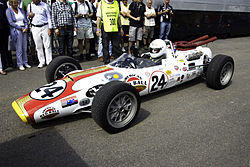 | |||||
| Indianapolis Motor Speedway | |||||
|---|---|---|---|---|---|
| Indianapolis 500 | |||||
| Sanctioning body | USAC | ||||
| Season | 1966 USAC season | ||||
| Date | May 30, 1966 | ||||
| Winner | Graham Hill | ||||
| Winning team | John Mecom, Jr. | ||||
| Average speed | 144.317 mph (232.256 km/h) | ||||
| Pole position | Mario Andretti | ||||
| Pole speed | 165.899 mph (266.989 km/h) | ||||
| Fastest qualifier | Mario Andretti | ||||
| Rookie of the Year | Jackie Stewart | ||||
| Most laps led | Lloyd Ruby (68) | ||||
| Pre-race ceremonies | |||||
| National anthem | Purdue Band | ||||
| "Back Home Again in Indiana" | Ed Ames | ||||
| Starting command | Tony Hulman | ||||
| Pace car | Mercury Comet Cyclone GT | ||||
| Pace car driver | Benson Ford | ||||
| Starter | Pat Vidan [1] | ||||
| Honorary referee | Raymond Firestone [1] | ||||
| Estimated attendance | 275,000 [2] | ||||
| TV in the United States | |||||
| Network | ABC's Wide World of Sports | ||||
| Announcers | Chris Schenkel Rodger Ward | ||||
| Chronology | |||||
| |||||
The 50th International 500-Mile Sweepstakes was held at the Indianapolis Motor Speedway in Speedway, Indiana on Monday, May 30, 1966. The official program cover for the race celebrated both the 50th running of the race, and 150th anniversary of Indiana statehood.
Contents
- Race schedule
- Practice and time trials
- Background
- Practice
- Saturday May 14 – Pole Day time trials
- Sunday May 15 – Second Day Time trials
- Saturday May 21 – Third Day Time trials
- Sunday May 22 – Bump Day Time trials
- Starting grid
- Alternates
- Failed to qualify
- Race recap
- Start
- Race
- Controversy over who won the race
- Box score
- Race statistics
- Broadcasting
- Radio
- Television
- Gallery
- Notes
- References
- Works cited
Eleven of the 33 starters were eliminated in a first-lap accident right after receiving the green flag on the main stretch. Only A. J. Foyt was injured, hurting his hand scaling the catch fence trying to escape the wreck scene. Only seven cars, the fewest finishers ever, were still running by the end of the race. First-time starter Jackie Stewart led by over a lap late in the race in John Mecom's Lola T90-Ford. [3] However, inside ten laps to go, his oil pressure dropped too low due to a broken scavenge pump. Stewart parked the car, and after briefly attempting to push some ways, he walked back to the pits. Fellow first-time starter Graham Hill inherited the lead and led a total of 10 laps to win, the first rookie winner since 1927. Despite parking his car, Stewart was voted the rookie of the year over Hill, completing enough laps to finish in 6th place.
Defending race winner Jim Clark spun twice during the race, and finished second. A mild controversy developed at the conclusion of the race, as Clark's crew - and some observers - erroneously believed their car was the race winner over Hill. However, during post-race review, the scoring serials were settled later that evening, confirming Hill the race winner and Clark placing second. For the second year in a row, the Wood Brothers from the NASCAR Grand National circuit were invited to work pit stops, this time for Dan Gurney. However, the car dropped out of the race in the crash on the opening lap. [4]

